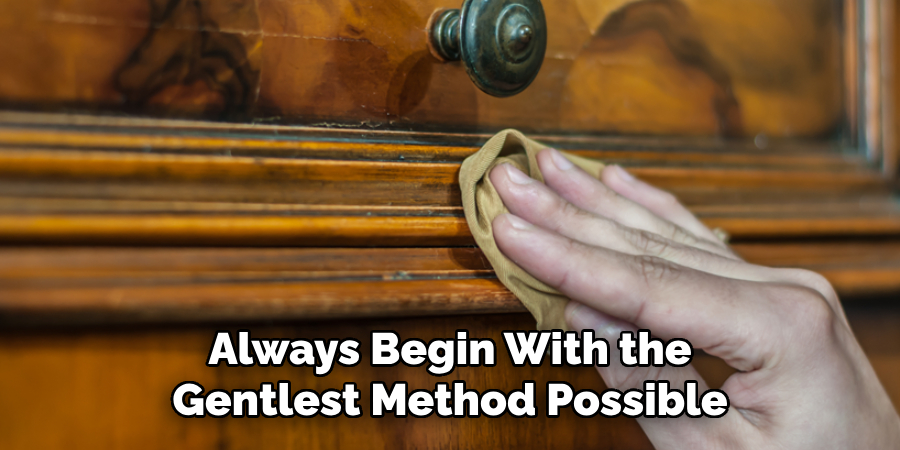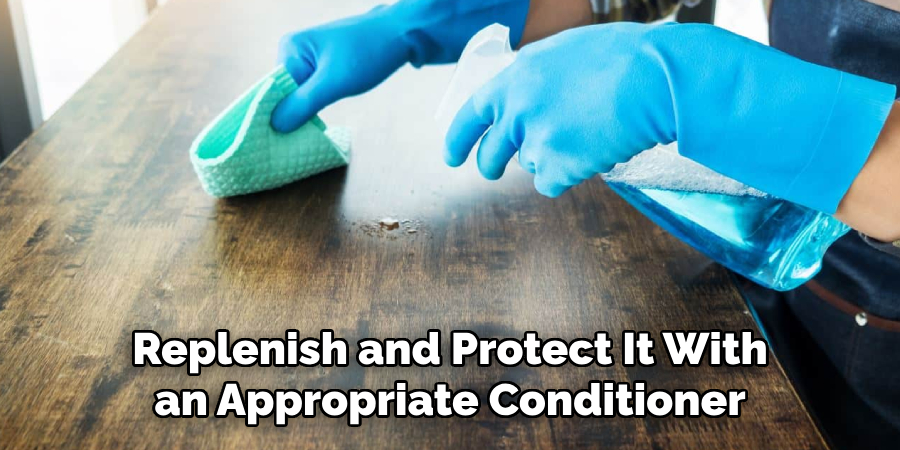Restoring old wooden furniture to its former glory can be a rewarding and satisfying task. Over time, wooden pieces can accumulate dust, grime, and scratches, which dull their natural beauty. Proper cleaning and maintenance not only enhance the appearance of the furniture but also preserve its durability and value. Whether it’s an antique heirloom or a modern wooden piece, understanding the right techniques and materials is key to ensuring its longevity. This guide will provide you with How to clean old wooden furniture.

Common Challenges
Restoring old wooden furniture can come with several challenges that require careful attention and precision. One common issue is tackling deep scratches or dents that may have developed over years of use. These imperfections can be tricky to repair without potentially damaging the surrounding wood. Another challenge is dealing with accumulated grime, which can be difficult to remove without stripping the finish or discoloring the wood.
Additionally, old furniture may have faded or uneven finishes due to prolonged exposure to sunlight or moisture, requiring refinishing to restore its uniform appearance. Lastly, identifying the right type of wood and finish used in the piece is essential, as applying incompatible treatments can worsen the condition rather than improve it. Overcoming these obstacles requires patience, the right tools, and knowledge of effective restoration techniques.
Tools and Supplies You’ll Need
To restore old furniture effectively, having the right tools and supplies is crucial. Basic tools like sandpaper in various grits, a scraper, and a sander will help remove old finishes and smooth the surface. Wood filler is essential to repair cracks or holes, while a putty knife aids in its application.
For cleaning the piece, use a gentle wood cleaner or mineral spirits to remove dirt and grease. Depending on the project, you may need a chemical stripper or a heat gun for stripping more stubborn finishes. Other supplies, such as brushes, rags, and gloves, are necessary for applying stains, sealers, or varnishes while protecting your hands from harsh chemicals. Lastly, ensure you have a good-quality finish like lacquer, shellac, or polyurethane, tailored to the specific requirements of your furniture piece. With these tools and supplies, you’ll be well-equipped for a successful restoration project.
10 Methods How to Clean Old Wooden Furniture
1. Begin with a Dry Dusting Using a Microfiber Cloth

Cleaning old wooden furniture should always begin with the gentlest method possible, and that starts with simple dry dusting. Use a clean, soft microfiber cloth to gently wipe away surface dust and grime. This step is crucial because it removes loose particles that can act like sandpaper if wet-cleaning begins prematurely. Start from the top of the piece and work your way down, moving in the direction of the wood grain. Avoid using feather dusters or abrasive cloths that might scratch or drag dirt into crevices. This dry method respects the integrity of the wood and prepares it for deeper cleaning.
2. Use a Mild Soap Solution for Light Cleaning
Once the dust is removed, proceed with a gentle cleaning solution composed of a few drops of dish soap mixed into warm water. This method is effective at removing oils, fingerprints, and everyday grime that have settled over time. Dampen a soft cloth (never soak it) in the solution and wring it out thoroughly. Wipe the wood along the grain, taking care not to oversaturate the surface. Follow up immediately with a dry, absorbent cloth to prevent moisture from seeping into the wood. This approach is especially suitable for varnished or sealed wood surfaces.
3. Clean Intricate Carvings with a Soft-Bristled Brush
Antique furniture often features ornate details like carvings, turned legs, and moldings. These hard-to-reach areas can accumulate dust and residue over the years. A soft-bristled brush—such as a clean paintbrush, soft toothbrush, or makeup brush—works wonders here. Gently brush into the grooves and crevices, being careful not to apply pressure that could damage fragile or chipped areas. For added effectiveness, you can lightly mist the brush with the soap solution, but ensure it stays nearly dry to avoid moisture accumulation in tight spaces.
4. Use White Vinegar for Grime and Build-Up
White vinegar, when properly diluted, is an excellent natural cleaner for tackling stubborn dirt and cloudy residues on wooden surfaces. Mix equal parts vinegar and water, then test the solution on a hidden area of the furniture to ensure it doesn’t damage the finish. Dampen a cloth with the mixture and gently rub the surface, again following the grain. Vinegar cuts through greasy residues and can help restore a dull finish. Always follow this method with a clean, damp cloth to remove any acidic residue, then dry thoroughly.

5. Address Sticky Residue with Mineral Spirits
Sometimes, soap and water aren’t enough, especially when dealing with sticky spots, wax buildup, or old polish residue. Mineral spirits, a gentle solvent available at hardware stores, can be used to break down these stubborn films without harming the finish—when used carefully. Always wear gloves and ventilate your work area. Apply a small amount to a cloth and gently rub the affected area in a circular motion. Use sparingly and wipe with a dry cloth afterward. This method is ideal for cleaning old furniture that hasn’t been restored in decades.
6. Treat Mold or Mildew with a Vinegar and Water Spray
If you discover mold or mildew on wooden furniture, perhaps from storage in a damp basement or attic, you’ll need to treat it promptly. Mix equal parts white vinegar and water in a spray bottle, apply it to the affected areas, and wipe with a clean cloth. Vinegar’s natural antifungal properties will kill most common molds and mildews. After cleaning, place the furniture in a dry, well-ventilated space to allow it to air out completely. Avoid using bleach, which can damage wood and strip its finish.
7. Polish and Protect the Finish with Furniture Wax or Oil

After thoroughly cleaning the wood, it’s important to replenish and protect it with an appropriate conditioner. For finished or sealed furniture, a quality paste wax or beeswax polish can revive the luster and offer protection against future dirt buildup. For oil-finished pieces, products like boiled linseed oil or tung oil work better. Apply the wax or oil using a soft cloth, working it into the surface in small, circular motions. Let it sit according to the manufacturer’s instructions, then buff to a sheen with a clean, dry cloth. This step helps highlight the natural beauty of the wood grain.
8. Remove Water Rings with Mayonnaise or Baking Soda Paste
Old wooden furniture often bears the scars of water rings from forgotten glasses or vases. To remove these, apply a small dab of full-fat mayonnaise directly onto the stain and let it sit for an hour. The oil content helps rehydrate the wood and lift the moisture mark. Alternatively, create a paste using baking soda and water. Rub it gently over the water stain with a cloth, working in the direction of the grain. After treatment, wipe clean and apply furniture polish to restore the shine. Always test any method on an inconspicuous area first.
9. Erase Scratches with Walnut or Touch-Up Markers
Minor surface scratches can age an otherwise well-preserved piece. One gentle method is to rub the meat of a walnut over the scratch—its natural oils darken the wood and reduce the visibility of the blemish. Let the oil sit for a few minutes, then buff with a soft cloth. Alternatively, use a wood touch-up marker that matches the furniture’s finish. These are especially handy for blending in nicks and dings along corners or edges. For deeper scratches, you may need a wood filler or professional restoration, but these DIY tricks work wonders for shallow marks.
10. Maintain with Regular Care and Controlled Environment
Once your wooden furniture is clean and restored, maintaining its condition becomes a long-term effort. Dust regularly with a microfiber cloth to prevent dirt accumulation. Avoid placing items that hold moisture or heat directly on the surface, and use coasters and pads as a preventative measure. Keep the furniture away from direct sunlight, which can fade finishes, and avoid fluctuating humidity levels, which can cause warping or cracking. Using a humidifier in dry winters or a dehumidifier in muggy summers helps maintain stable conditions. With proper care, your vintage wood furniture can remain beautiful for decades to come.

Conclusion
Cleaning old wooden furniture is both a science and an art—balancing care, precision, and respect for craftsmanship. From gentle dusting to specialized stain removal, each method ensures that the natural character of the wood is preserved and enhanced. Whether you’re a collector, restorer, or simply someone who cherishes heirloom pieces, applying these methods will help extend the life and charm of your furniture for generations. Be sure to follow all instructions on How to clean old wooden furniture carefully, and always consult an expert when in doubt.
About the Author
Adrian Green, a lifelong woodworking enthusiast, shares his passion for the craft through The Woodenify Blog. With a foundation built on years of hands-on experience in his father’s woodworking shop, Adrian is dedicated to helping others learn and grow in the world of DIY woodworking. His approach to woodworking combines creativity, practicality, and a deep appreciation for the art of building with your own hands. Through his blog, he inspires individuals of all skill levels to embark on their own woodworking journeys, creating beautiful, functional pieces of furniture and décor.
Professional Focus
- Specializes in DIY woodworking projects, from furniture to home décor.
- Provides step-by-step guides and practical tutorials for woodworkers of all skill levels.
- Dedicated to helping readers build confidence and skill through easy-to-follow instructions and tips.
- Passionate about fostering a community of makers who can share, learn, and grow together.
Education History
- University of Craft and Design – Bachelor of Fine Arts (BFA) in Woodworking and Furniture Design
- Woodworking Apprenticeships – Extensive hands-on training with skilled craftsmen to refine carpentry and furniture making techniques.
- Online Courses & Masterclasses – Continued education in advanced woodworking techniques, design principles, and specialized tools
Expertise:
- DIY woodworking, carpentry, furniture making, and home décor projects.
- Creating accessible tutorials and guides for beginner to advanced woodworkers.
- Sharing the joys and satisfaction of woodworking, from raw materials to finished products.
